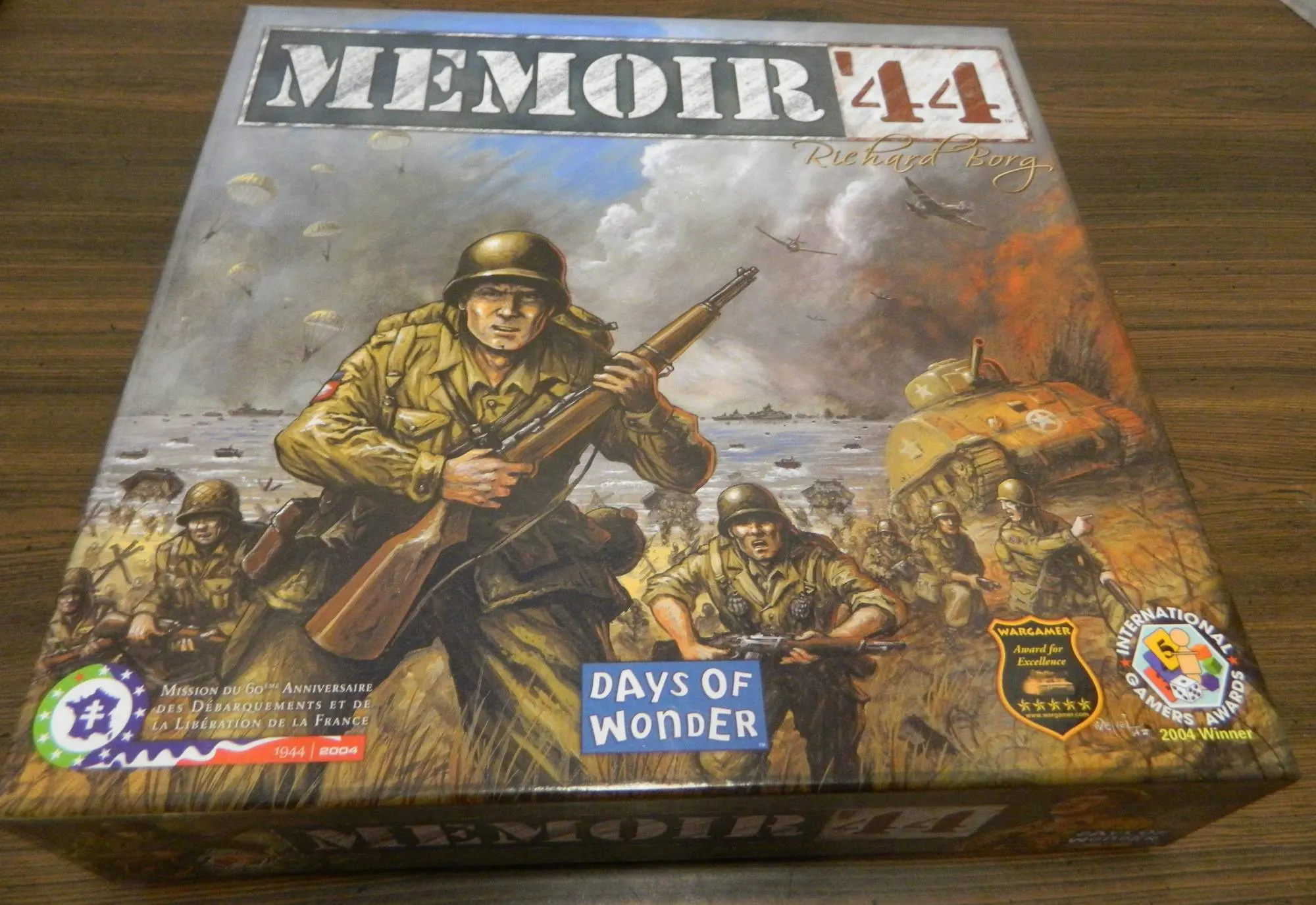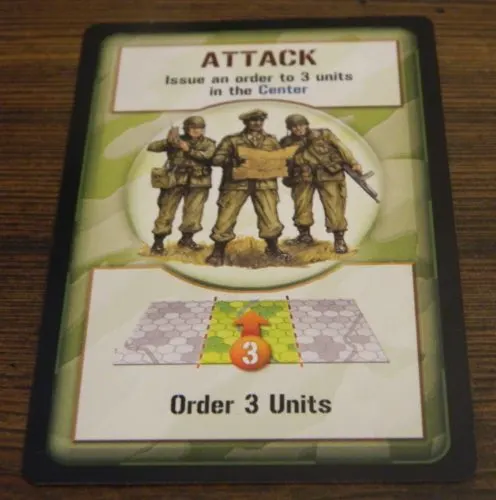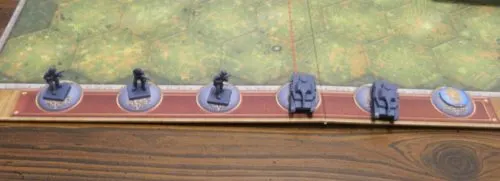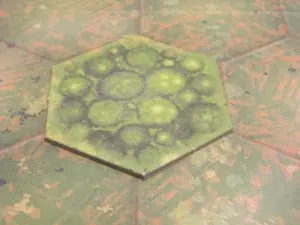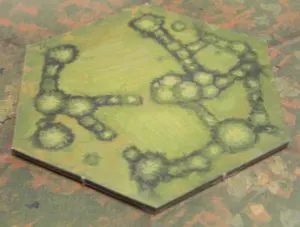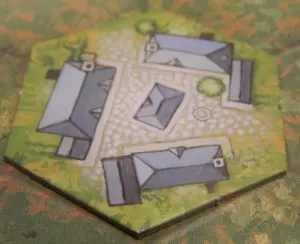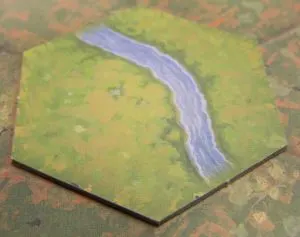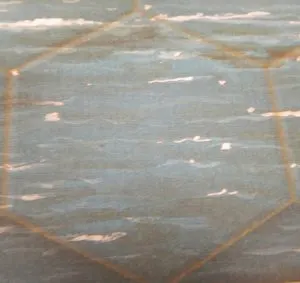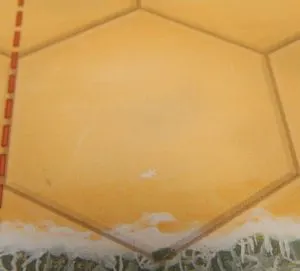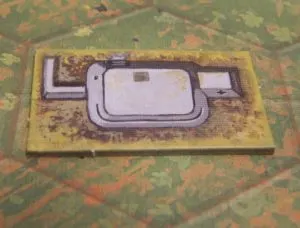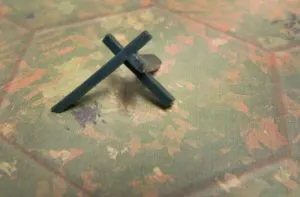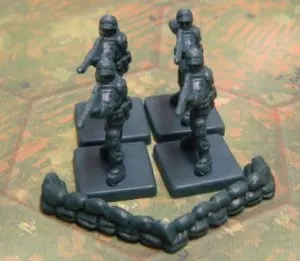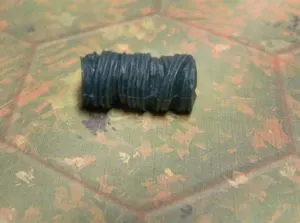Despite being a pretty popular board game genre, we haven’t looked at a lot of board games in the war game genre in the past on this site. I think this is mostly because a lot of war games contain overly complex rules and are pretty dull for the most part. Even though I have not played a lot of war games, I was interested in the genre because it has a lot of potential. As I was not that interested in trying one of the more complex war games I decided to try out Memoir ’44 as it is generally regarded as one of the best war games that is also pretty accessible. Memoir ’44 does a great job creating a war game that is accessible while also still having depth but it might not be for everyone.
How to Play Memoir ’44
As you need the instruction booklet for the scenario setups, this look at how to play Memoir ’44 won’t be as in depth as a normal review on Geeky Hobbies. It will give you a look at all of the rules needed to play the game but it doesn’t include all of the special case rules and does not include the scenarios.
Setup
- Choose the scenario that you plan on playing. The scenario you choose will impact the rest of setup.
- Place the gameboard in the middle of the table with the appropriate side face up.
- Place the necessary tiles and obstacles on the board.
- Place each players’ units on the appropriate spaces on the gameboard. Place four infantry, three armors, and two artillery in each unit.
- Add any special unit badges and victory medals to the board.
- Place the terrain summary cards used in the scenario to the side of the board.
- Assemble the card holders. Shuffle the command cards and deal the appropriate number of cards to each player. The rest of the cards form the draw pile.
- Each player/team chooses which side they will control. As the battles are usually short and some favor one of the two sides, you probably should play the battle two times giving each player an opportunity to play both sides of the battle.
- Each player/team takes four of the combat dice.
- The scenario will list which player/team gets to start the battle.
Playing the Game
On a player’s turn they will take the following actions:
- Play a card.
- Announce which units you are going to order.
- Move the units you chose to order.
- Battle with units you chose to order
- Draw a new card.
Cards
In Memoir ’44 there are two different types of cards: section and tactic.
A section card will give you a section(s) of the map and how many units you will get to order.
Tactic cards are special cards that can give you special actions in the game. Follow what the card says for your turn.
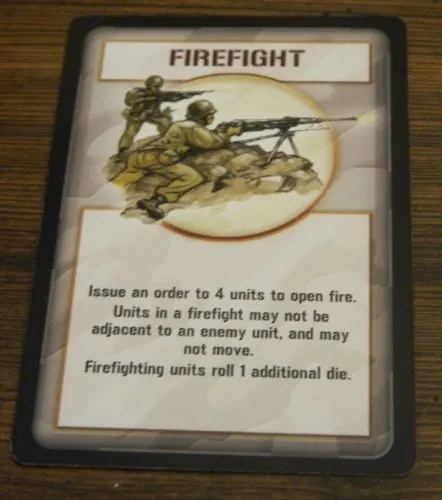
This tactic card allows the player to immediately fire with four units and allows them to roll one additional die.
Order Units
For future reference a unit is a group of figures that occupy one space on the gameboard.
In order to move, battle or take another action with a unit you have to order the unit. When a player plays a section card it will indicate one or more sections. The player can only choose to order units from that section(s). If a unit is on one of the spaces that has the red line through it, the unit is considered to be in both sections. Each unit can only be ordered once. If you can’t use all of the orders on the card, you lose the remaining orders.
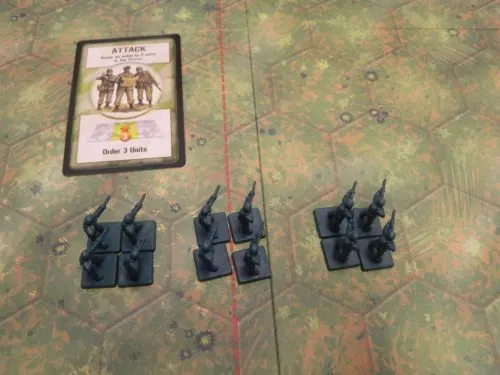
This section card allows the player to move three units in the center section. The unit on the right is in the center section. The unit in the middle is also in the center section as the red line indicates that the space is in the left and center section.
Move Units
When moving units you must move one unit at a time and must complete its entire movement before you move another unit. When moving a unit each adjacent space that the unit moves to counts as one space. How a unit moves is dependent on its type.
Infantry have two options when it comes to movement.
- Infantry can move one space and then battle.
- Infantry can move two spaces but then can’t battle. Special forces infantry ignore this rule and can move two spaces and still battle.
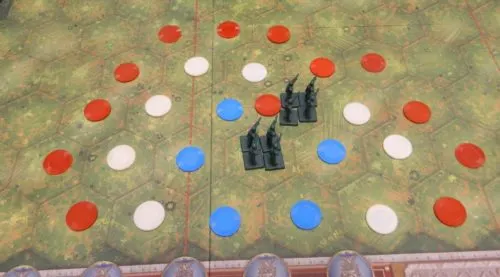
The bottom infantry unit can move to any of the spaces with a blue chip and still attack. The infantry unit can move to any white space and not attack. The infantry unit can’t move to any of the spaces with a red chip.
Armor can move up to three spaces and battle.
Artillery can either move one space or battle.
Other rules regarding movement include:
- A unit that is ordered does not have to move.
- A unit cannot be moved through or onto a space occupied by another unit.
- Units cannot be split into two different units. Units also cannot be combined into one.
- Some types of terrain affect movement.
Battle
When battling a player will resolve one battle at a time before moving onto the next battle. An ordered unit is not forced to battle and can only battle once per turn. The unit is only allowed to target one enemy unit each turn. When battling a unit a player must follow this process:
- Declare Target
- Determine Number of Battle Dice
- Roll Dice and Determine Outcome
Declare Target
Before declaring a target unit, a player has to check whether the unit is within range. If the target unit is not in range, it can’t be attacked. The range of the different units are as follows:
- Infantry: 3 spaces away
- Armor: 3 spaces away
- Artillery: 6 spaces away
In addition to determining whether a target unit is within range, you must determine whether it is within line of sight (artillery does not need line of sight). To determine whether the target is within line of sight you imagine a straight line running from the center of the attacking unit’s space to the center of the space of the target unit. If there is nothing in the path of the imaginary line, the unit has line of sight. If there is an obstruction between the two spaces (not including the space that the target is on) the unit does not have line of sight and thus can’t attack the unit. Obstructions that block line of sight include:
- Your units or your opponent’s units.
- Forests
- Hedgerows
- Hills (if not firing from one hill to another hill)
- Towns
- Bunkers
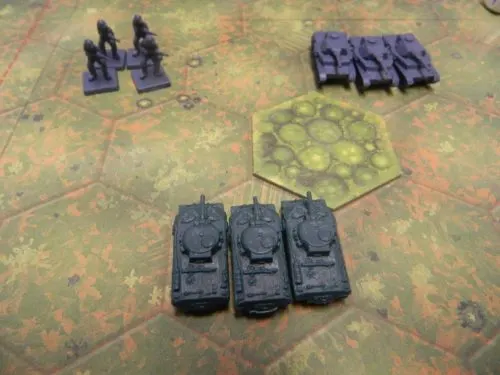
This allied armor unit has line of sight with the axis infantry. The forest blocks the line of sight to the other armor unit.
Determine Number of Battle Dice
The number of dice that a player will roll depends on several factors.
The first determining factor is how far the attacking unit is from the target. To determine how many dice that a unit gets to use, you will use a technique called counting down. When counting down you start with the space closest to the attacking unit and announce the next number on each space until you get to the target unit. The count down numbers for each type of unit is as follows:
- Infantry: 3, 2, 1
- Armor: 3, 3, 3
- Artillery: 3, 3, 2, 2, 1, 1
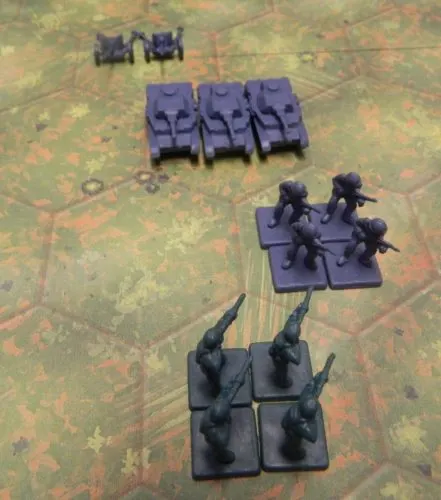
For the allied infantry unit at the bottom they would get to roll three dice against the axis infantry, two dice against the armor, and one dice against the artillery (disregarding that line of sight would be blocked).
After you have determined the starting number of attack dice, you may lose some dice due to terrain or obstacles.
Rolling the Dice and Determining the Outcome
A player will roll all of their attack dice for the battle at the same time. Each battle dice has the following symbols:
- Infantry (2): If you roll an infantry symbol and are attacking an infantry unit, you will kill one of the soldiers in the unit.
- Armor: If you roll an armor symbol and are attacking an armor unit, you will destroy one of the tanks in the unit.
- Grenade: If you roll a grenade it will destroy one figure in the unit you are attacking.
- Star: Generally rolling a star does nothing outside of special actions on some of the cards that are played.
- Flag: Rolling a flag forces the unit that is being attacked to retreat one space.
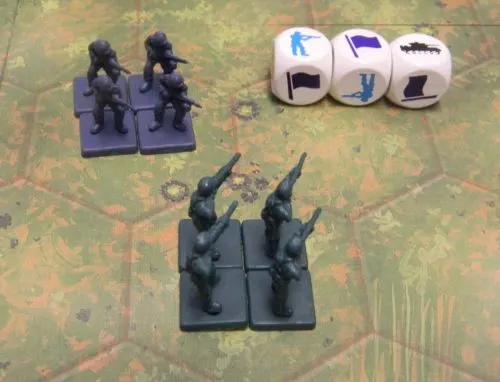
The allied player has rolled one infantry, one flag and one armor. The allied player will remove one of the axis figures. The flag symbol will force the axis soldiers to retreat one space. The armor symbol will do nothing.
When all of the figures from a unit have been removed from the board, that unit has been destroyed. The player that destroyed the unit will take one of the figures and place it on one of the medal spots on their side of the board as it counts as one victory point.
Retreat
When a player rolls one or more flag symbols the attacked unit will have to retreat if it is not destroyed. The unit will have to retreat one space for each flag rolled. When retreating the player who controls the retreating unit will have to move the unit one space towards their side of the board. Some obstacles on the board have some special abilities with regards to retreating. When retreating a unit cannot move onto the following spaces:
- A space occupied by another unit.
- Rivers
- Oceans
If a unit is not able to retreat all of the required spaces, they will lose one figure for each space they were unable to move.
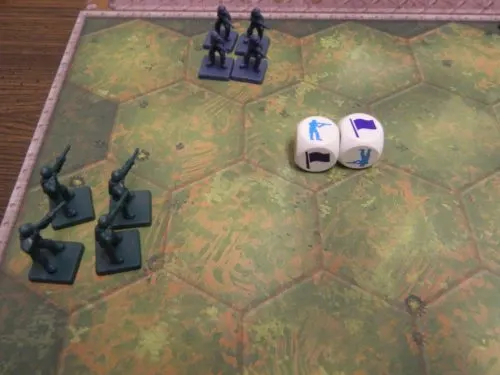
In this battle the allied infantry unit kills one of the axis figures. The axis unit also has to retreat one space. Since the unit can’t retreat one space, they will lose another figure.
Close Assault
A unit is considered to be in close assault if it is on a space adjacent to an enemy’s unit. When a unit is in close assault it has to attack the adjacent unit or not attack at all. When a unit in close assault either destroys a unit or forces it to retreat it has the option of “taking ground” (except for artillery). When taking ground a unit has to follow the restrictions of the terrain of the space they are moving towards. How a unit takes ground depends on whether it is infantry or armor.
When infantry take ground they move onto the space occupied by the unit that was attacked.
When an armor takes ground it moves onto the space occupied by the unit that was attacked. The armor then has the ability to attack again. If the armor wins the second battle they can move to the vacated space but they are unable to attack again.
Draw a New Card
Once a player has completed all of their battles they will draw a new command card. The other player will then take their turn.
End of Game
When one player has acquired enough victory points (dependent on the scenario) they win the round. If you are playing where each player will play both sides, you play another round. The player to acquire the most points between the two rounds wins the game.
Additional Rules
Terrain
Forests
- When a unit enters a forest they must stop their movement immediately.
- A unit may not attack on the turn that it enters a forest.
- When attacking a unit in a forest, infantry lose one combat die and armor lose two combat dice.
Hedgerows
- To move onto a hedgerow a unit has to be on an adjacent space. Their movement stops immediately when they enter the hedgerow. When leaving a hedgerow the unit can only move to an adjacent space.
- A unit cannot attack on the turn that it enters a hedgerow.
- When attacking a unit in a hedgerow, infantry lose one combat die and armor lose two combat dice.
Hills
- When both the attacking unit and target unit are both on hills, there is no impact on combat. When only the target is on a hill, infantry and armor lose one combat die.
- A hill blocks line of sight if the units are not at the same height as the hill.
Towns
- When entering a town the unit must stop movement for the rest of the turn.
- A unit may not attack on the same turn that it enters a town.
- When attacking a unit in a town, infantry lose one combat die while armor lose two combat dice.
- Armor attacking from inside a town will lose two combat dice.
Rivers
- Units cannot move onto or through a river space unless there is a bridge on the space.
Oceans
- While moving on the ocean a unit can only move one space per turn.
- While on the ocean a unit may not attack.
Beach
- Units can only move up to two spaces on the beach.
Obstacles
When an obstacle is on a terrain tile, only the highest dice reduction is used.
Bunkers
- Armor and artillery units may not move onto bunker spaces.
- Artillery units that start on a bunker space cannot move from the bunker. If an artillery is forced to retreat, it loses figures instead of retreating.
- Infantry units can attack the turn they move onto a bunker space.
- Only the side mentioned in the scenario can take a defensive position in a bunker.
- When attacking a unit on a bunker space, infantry lose one combat die while armor lose two combat dice.
- A unit in a bunker can ignore the first flag rolled against it.
Hedgehogs
- Armor and artillery cannot enter spaces with hedgehogs on them.
- Units on a space with a hedgehog can ignore the first flag rolled against them.
Sandbags
- When a unit leaves a sandbag space it is removed from the board.
- When a unit on a space with a sandbag is attacked, infantry and armor units lose one combat die. The unit can also ignore the first flag rolled against it.
Wire
- When a unit enters a space with wire they must stop moving immediately.
- If an infantry unit is on a space with wire and attacks another unit they will lose one combat die.
- An infantry unit can choose to remove the wire from the board instead of attacking. Armor removes the wire and can still attack.
Special Units
Some of the scenarios will give players special units. Units on a scenario map with rounded corners indicate a special unit. If the unit has a number on it, it indicates how many figures the unit has if it is different than the normal type of that unit.
French Resistance
French resistance troops follow all of the rules for normal infantry except for the following:
- Can still attack when they enter woods, towns, or hedgerows.
- Can retreat three spaces instead of one for each flag rolled.
- Always start with three figures instead of four.
Special Forces
- Can move two spaces and still battle.
Elite Armor
- Contains four figures instead of the normal three figures.
My Thoughts on Memoir ’44
As I mentioned earlier I haven’t played a lot of war games in the past. The main reason for not playing more games in the genre is that for the most part war games are intimidating. They contain a lot of specific rules that take a long time to learn. Being a player that likes to spend more time actually playing a game than learning the rules, I have mostly stayed away from these more complicated war games. To see whether I even enjoyed war games at all I thought it was a good idea to start with a game like Memoir ’44 as it is generally considered to be a more accessible game from the genre.
When I first looked at the instruction booklet for Memoir ’44 I have to admit that I was a little intimidated. The rulebook for the game is actually quite long as there is quite a bit to the game. Memoir ’44 is not a game that you can explain to new players in a couple minutes as you have to teach them quite a few mechanics. I would say that it probably will take most people 10-15 minutes to teach the game to new players. Basically Memoir ’44 is one of those games that has a learning curve where it will take you a couple turns to fully know what you are doing. Once you know what you are doing though things go much more smoothly as the game itself is pretty straightforward.
I would say that Memoir ’44 is the next logical step up from a game like Risk. Memoir ’44 takes some mechanics similar to Risk and adds a little more strategy which adds a little more depth to the game. While Memoir ’44 has quite a bit more to it than Risk, I would say that it is probably closer to Risk than some of the more complicated war games. This will turn off people that are used to playing more complex war games but I think this is the right difficulty level for most people.
Personally I think Memoir ’44 is pretty much the perfect blend of strategy and accessibility. I am a firm believer in the idea that board games should never be made more complicated than they have to be. Mechanics that don’t really add much to a game and mostly just add complexity should be cut so the game can focus on the mechanics that are the most important and fun. Unless a game is something you are going to play all of the time, you should not have to spend more time learning how to play the game than actually playing the game. Memoir ’44 succeeds because it focuses on what is most important, being fun. Memoir ’44 is a fun and accessible board game that people who generally don’t play board games can still enjoy.
On the strategy spectrum I would say that Memoir ’44 is in the moderate level. While the actions you can take on any given turn are determined by what cards you have access to (more on this later), you actually have quite a few decisions to make on your turn. You have to decide which card to play, which units to use, how you are going to move them and which units you are going to target. What you choose to do in the game is going to have an impact on how successful you are. Making smart decisions will improve your odds in the game while making bad decisions will make it harder to win.
I would say the biggest problem that I have with Memoir ’44 is that it actually relies on quite a bit of luck. Like most war games it relies on quite a bit of dice rolling. Since the game relies on rolling dice, how well you roll will have an impact on how well you do in the game. It doesn’t matter how good your strategy is if you don’t roll the right symbols at the right times. If one player rolls significantly better than the other player, they likely will win. Any game that utilizes dice will have to deal with this luck in some way. I don’t mind some of the luck but I kind of wish the game could have found some way of giving players something if they roll symbols that they are unable to use. This would have minimized some of the luck in the game.
While the dice add a lot of luck to the game, I could argue that the cards add almost as much luck to the game. The cards add some luck to the game in a couple ways. First some cards are just better than others. Some section cards allow you to order more units while some tactic cards give you a power that can really benefit a player. The other way that the cards add luck to the game is that you might just not draw the cards you need for your desired strategy. For example you might want to order troops on the right side of the board. If you don’t have any cards that let you order troops on the right side though you are unable to take that action. While I like that this forces players to sometimes change up their strategy, I think it also adds a little too much luck to the game.
So when you look at the strategy vs luck spectrum with regards to Memoir ’44 it honestly feels like it is somewhere right in the middle. The game is far from the most strategic war game. There is some strategy to the game as if you make bad tactical choices you will decrease your chances of winning the game. At the same time though strategy alone is not going to determine your success. You could have the superior strategy and yet the other player could win solely because they were luckier than you. While I wish there was a little more strategy I don’t mind that much as Memoir ’44 does a good job balancing the two extremes. People who play more advanced war games though will probably find Memoir ’44 to be overly simplified.
On the length front I think Memoir ’44 is around the right length. Memoir ’44 has an estimated game length of 30-60 minutes but I disagree with that assessment some. Generally I think you could finish a game of Memoir ’44 within 30 to 60 minutes. The problem is that in most cases you are likely going to want to play two games. This is mostly due to the fact that it seems like a lot of the scenarios included with the base game seem to favor one of the two sides. For example in the first scenario the allies have a pretty significant advantage as it is a battle where the allies caught the axis soldiers by surprise. With one side generally having an unfair advantage I don’t think it is fair to have one player/team have a slim chance of winning the game. Therefore you generally have to play two games where each player/team gets to play both the allies and axis side and the winner is the player/team that does best between the two games. While things will speed up the more you play the game, if you play both sides of a battle I find it unlikely that you can finish a game in under an hour.
This is probably not going to matter to everyone but I have to give Memoir ’44 credit for actually putting in a lot of effort to try to make the scenarios as historically accurate as possible. For each scenario in the game there is the backstory for the battle which gives you quite a bit of historical information. Richard Borg seems to have put quite a bit of effort into researching each of the battles. While some people will disregard this entirely, I think people that are interested in World War 2 battles will appreciate the amount of effort put into the game to try to make it as historically accurate as possible.
On the component front just like with all Days of Wonder games I think Memoir ’44 does a really good job. While the pieces are only made of cardboard and plastic, they actually show a surprising amount of detail. The game includes 144 figures and they show quite a bit of detail. I really appreciate that the two armies actually have units designed differently even though I think the unit colors could have been differentiated a little more. The game also comes with a lot of terrain and other obstacles which truly gives you a lot of customization options. The game includes 15 scenarios in the booklet but the game gives you plenty of components that you could easily create your own scenarios. I would say that the biggest complaint that I had with the components is that they are kind of hard to fit back into the box.
Another area where Memoir ’44 really excels is the fact that Days of Wonder has really supported the game. Memoir ’44 has had around ten different official expansions and there are plenty of other fan made scenarios as well. The expansions include adding air troops, different factions from World War 2, many different scenarios, and other mechanics to expand the original game. With so much additional material added to the game, if you like Memoir ’44 it would be hard to ever run out of new content for the game.
Despite enjoying Memoir ’44 quite a bit, I still have to admit that I think the game is a little overrated. At the time of writing this review Memoir ’44 is rated around the 100th best board game of all time. Memoir ’44 is a very good game but I don’t know if it is worthy of that high of rating. Maybe it is just that I am not that big of war game fan.
Should You Buy Memoir ’44?
If I had to describe Memoir ’44 in a couple words I would say that it is the accessible war game. While a lot of war games like to get into the nitty gritty of combat with complicated rules to more accurately simulate battle, Memoir ’44 is more focused on concentrating on a few fun mechanics. For the most part I think the game succeeds in that task. The game has a little learning curve but once you get a hang of the game it is quite easy to play. The game has a decent amount of strategy but not so much strategy that the game becomes dull. I will say that Memoir ’44 does rely a little too much on dice and card luck at times but for the most part does a good job balancing luck and strategy. The game also does a good job adding historical accuracy to the game and giving players plenty of variety.
If you aren’t really interested in war games, Memoir ’44 is unlikely to change your mind. If you are already into more complicated war games I also don’t think it will be for you. For people looking for a more accessible war game though I don’t think you could do much better than Memoir ’44.
If you would like to purchase Memoir ’44 you can find it online: Amazon, eBay
If you are interested in the Memoir ’44 expansion packs you can find them online as well: Battles of Khalkin Gol Expansion, Breakthrough Expansion
, Eastern Front Expansion
, Mediterranean Theater Expansion
, Pacific Theater Expansion
, Terrain Pack Expansion
, Through Jungle and Desert Expansion
, Winter/Desert Map Expansion
, Winter Wars Expansion

